Phidippus audax, commonly known as the daring jumping spider is a jumping spider found throughout the USA. As their name suggests, the daring jumping spider is known for its audacious jumps. It can jump up to 50 times its own body length.
Description of the Daring Jumping Spider
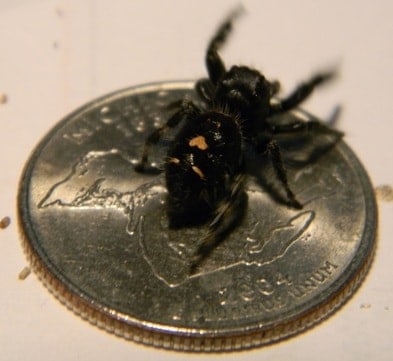
Phidippus audax are black with three marks on the abdomen. When they are young, the three spots on the abdomen are of orange color. As they grow older, those markings will turn white. The abdomen is larger than the cephalothorax. It can easily be mistaken with a male Regal Jumping spider that has a very similar appearance and markings.
The legs are short for spiders and it uses its back legs for its jumps. The spider suddenly increases blood pressure in the back legs which catapults it towards its destination.
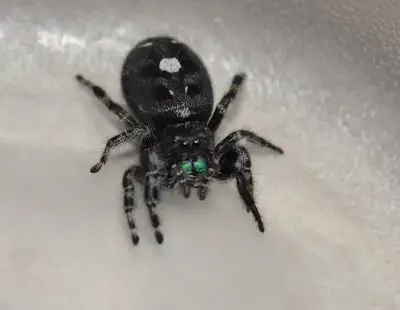
They have eight eyes. Four across the front and two along each side. The two middle eyes in the front are much larger than any others.
The most telling feature to distinguish the Daring Jumping Spider from other Jumping Spiders are the fangs. The Daring Jumping Spider’s chelicerae has a green metallic coloring.
Size
The Daring Jumping Spider will grow to about 3/4 inch (19 mm).
Web
Being hunters, the only time the daring jumping spider spins a web is just before the jump. They will attach a drag-line to the surface it is jumping from in case the jump fails. And sometimes they create webs as pup tents at night to rest in.
Bites
Jumping Spiders will usually run and hide rather than attack a human, but there are cases where people do get bit. They get listed in the little to no risk category. However, there are cases of the bites causing pain and significant swelling. The more serious, but rare cases can cause headaches, fever, chills, nausea and vomiting that can last a few days.
Scientific Classification of Phidippus audax
- Kingdom: Animalia
- Phylum: Arthropoda
- Subphylum: Chelicerata
- Class: Arachnida
- Order: Araneae
- Infraorder: Araneomorphae
- Family: Salticidae
- Genus: Phidippus
- Species: Phidippus audax
Other Names
Daring Jumping Spider or Bold Jumping Spider.
Distribution of the Daring Jumping Spider in the USA

The daring jumping spider can be found in every US state – Alabama, Alaska, Arizona, Arkansas, California, Colorado, Connecticut, Delaware, Florida, Georgia, Hawaii, Idaho, Illinois, Indiana, Iowa, Kansas, Kentucky, Louisiana, Maine, Maryland, Massachusetts, Michigan, Minnesota, Mississippi, Missouri, Montana, Nebraska, Nevada, New Hampshire, New Jersey, New Mexico, New York, North Carolina, North Dakota, Ohio, Oklahoma, Oregon, Pennsylvania, Rhode Island, South Carolina, South Dakota, Tennessee, Texas, Utah, Vermont, Virginia, Washington, West Virginia, Wisconsin, Wyoming
More pictures of the daring jumping spider
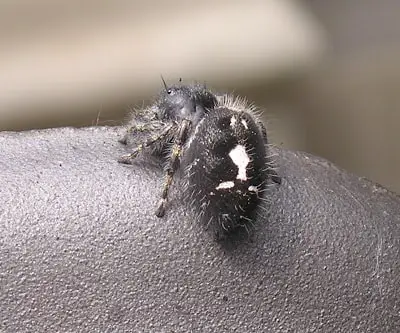
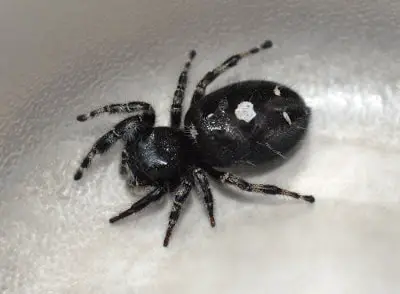
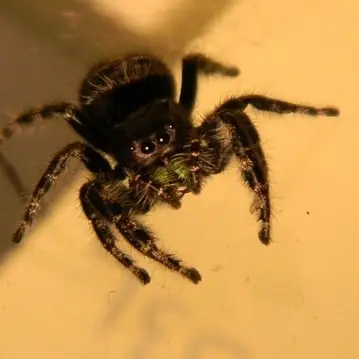


Apologies if this has already been identified- I couldn’t find it myself. Found on the rock beach near Mount Saint Sauveur Acadia National Park, Maine.
Hello Grace,
Thank you for getting in touch. The spider you found is a jumping spider (Phidippus purpuratus). We don’t have an overview article about them yet – but will create one soon. You can find more information about jumping spiders in this post about a close relative of your spider: http://usaspiders.com/phidippus-audax-daring-jumping-spider/
I’ve been spending hours trying to find out what kind of jumer my little girl is, i live in Texas close to the gulf, and she’s a female, i think she’s a dare devil jumper but I’m just not sure, i found her in my backyard. Could you tell me what she is? (Image of her from the top below)
Hi Lachlan,
It appears to be a Twin Flagged Jumper (Anasaitis Canosa). If you had a chance to observe it for a bit, you may have noticed the white marking on each pedipalp. They “wave” their pedipalps up and down repeatedly at times. Sort of like waving two white flags which may have inspired the common name. They are common in leaf littered woodlands, but I have also seen them in pineneedles where there were only a few pine trees overhead, as well as found several in and on my home which is not in the woods. Here is a video link if you want to observe their pedipalp waving behavior: https://archive.org/details/DavidEdwinHillCourtshipandmatingbehaviorofAnasaitiscanosajumpingspidersinGreenvilleCountySCUSA
And my other one show is really small and pretty, found her on my window a while back, i haven’t got a clue to what type of jumper she is however. If anyone has any ideas to what she may be that would be awesome!!! (Pic of her below)
Hello Lachlan, sorry about not getting back to your earlier. I overlooked the photo. Thanks for submitting this great find. This is a female Colonus sp. jumping spider. Most likely Colonus sylvanus: https://bugguide.net/node/view/247867
Great pic! I would like to know too. Very distinct markings on the head.
My husband found this spider in his camper shower. He recently traveled to Tupelo, Oklahoma. I’ve tried identifying the spider online but I can’t find one exactly like it. It looks similar to a black house spider but the back is more rounded. Me husband described the spider as a quarter in size. 🤷♀️The spider has light gray and white around it’s knuckles and is a little hairy.
Hello Sissy, thanks for getting in touch! This is a bold jumping spider, also called daring jumping spider (Phidippus audax). It’s not medically significant. You can read more about it here:
https://usaspiders.com/phidippus-audax-daring-jumping-spider/
Found on car in central nj
Car had not been out of state recently
Hello Lee, thanks for getting in touch! This is a Phidippus species jumping spider. They are absolutely medically significant spiders and fun to observe. It looks very much like a daring jumping spider (Phidippus audax): https://usaspiders.com/phidippus-audax-daring-jumping-spider/
I work at a local greenhouse in Michigan. This was waiting for me on the hose handle this morning.., and I can’t seem to ID it? We also have 8000+ plants from all over the U.S. – so maybe it isn’t a Michigan spider?
Hello Stacy, thanks for getting in touch! This is a bold jumping spider (Phidippus audax): https://usaspiders.com/phidippus-audax-daring-jumping-spider/
They are found throughout the United States and are not medically significant spiders.
I just found a male who looks almost exactly like the photo of the male in this description in the San Francisco Bay Area (east bay, just a few blocks from the water). You’d better revise that range map. I have seen several small Bold Jumping Spiders here (though they were actually quite shy), but this is the first time I have noticed this species.
Hello Cat, thanks for pointing that out. You are right, bold jumpers are now also found on the west coast as well as on Hawaii.
Hello Cat, sorry, there was some confusion. The spider on the image is a bold jumping spider – Phidippus audax. They are also found in the Western U.S. and in Hawaii. The post here is about Phidippus regius, which is strictly limited to the Southeastern U.S. Black P. regius can look almost identical to P. audax like the one on your picture: https://usaspiders.com/phidippus-audax-daring-jumping-spider/
Not much smaller than a pinkie fingernail. Black and looks like white “fuzzy” markings on body and legs. It has a turquois mark near its’ head and one much larger leg on the front right side. Hope the image is large enough to make an identification. Thanks
Hello Wendsong, thanks for getting in touch! This is a daring (or bold) jumping spider (Phiddipus audax): https://usaspiders.com/phidippus-audax-daring-jumping-spider/
Do jumping spiders fangs change color? I have been watching a video of one and I have noticed her fangs different colors.
Hello Tom, bold jumpers often have iridescent chelicerae or fangs. Depending on the angle you look at them, the color can range from silver, light blue, intense blue to even orange or reddish. Quite fascinating to look at them 🙂
This is our jumping spider!
Good Afternoon,
This little guy visited my balcony last night. I put out my finger and he jumped right on. I would tap further up my arm and he would jump where I tapped. He was a fun little guy. I know he/she’s a jumper, don’t know what kind? I put him back on one of my plants. I hope he hangs out for a while!
Hello Cynthia, this is almost certainly a red-backed jumping spider (Phidippus johnsoni):
https://usaspiders.com/phidippus-johnsoni-red-backed-jumping-spider/
Would you please confirm your location as P. johnsoni only occurs in the Western United States. If you are in the East, the ID would probably be wrong.
Found him having made a little web on my cactus in Central Ohio near Sunbury, north of Columbus. I had to shoo him out of his web, which looks vaguely like a venue flytrap, to get a picture of him. He’s sort of reddish-brown with more emphasis on the brown and has some white spots. He’s only got 4 eyes as far as I can tell. Definitely a bit hairy and quite annoyed with me.
I’m happy to leave him be so long as he isn’t dangerous, though I’m not sure he’ll be able to find much to eat in my room…
Hello Fiona, thanks for getting in touch! This is a jumping spider – not medically significant. It’s most likely a bold jumper (Phidippus audax): https://usaspiders.com/phidippus-audax-daring-jumping-spider/
They don’t spin webs, you’ve probably found it in or close to the web of another spider.
This little spider was on my kitchen window. First time seeing it.
Hello Esther, thanks for getting in touch! This is a jumping spider, most likely a bold jumper (Phidippus audax): https://usaspiders.com/phidippus-audax-daring-jumping-spider/
We have jumping spiders in Delaware. I usually see them on my deck by the pool in the summer. I observe mostly the adults, e.g., black and white, and while I am sitting in my lounge they will often climb on my arms and hang out for a bit. I love observing these little creatures. This summer, we saw one drinking out of our saltwater pool. I welcome these guys and it gives me pleasure that they are comfortable enough to spend time with us.
Saw this spider indoors on a wall. Boulder, Colorado, November 11, 2021. Centimeter or so long. No web, just walking on the wall. It is hairier than any of the spiders you have suggested. Google thinks it is a tarantula. What is it?
Bugguide thinks it is a jumping spider, genus Phidippus, possibly P. audax. Looks good to my untutored eye. What do you think?
Hello Matt, yes, this is definitely a Phidippus sp. jumping spider – P. audax seems plausible but the exact species level identification of Phidippus is tough from an image.
Hello USASPIDER,
I found this spider in the bathroom floor, size about 3/4 inch. I live in Beaverton, Oregon
Hello Dang, thanks for sharing this great shot! This is a bold jumping spider (Phidippus audax): https://usaspiders.com/phidippus-audax-daring-jumping-spider/
It’s not a medically significant spider.
October 2021. On yard fence in North Texas.
Found at the Reiman Gardens at Iowa State University, Ames, IA, in a plastic cap outdoors. It’s little, smaller than a dime.
Hi Ann, thanks for sharing this find! This is a daring jumping spider (Phidippus audax): https://usaspiders.com/phidippus-audax-daring-jumping-spider/
Found on back porch. San Antonio TX
Hi Wendy, this is a male daring jumping spider (Phidippus audax): https://usaspiders.com/phidippus-audax-daring-jumping-spider/
Discovered in Provo, UT.
Looks like a jumping spider eating a wolf spider or grass spider.
Primarily looking for an id on the jumping spider.
Hi Tommy, the jumping spider is a bold jumper (Phidippus audax): https://usaspiders.com/phidippus-audax-daring-jumping-spider/
This little guy found himself just inside the outside door in my laundry room. From what I could find he looks like a jumping spider of some kind. I live in Shelley, Idaho (about 20 minutes outside Idaho Falls), have lived in Idaho nearly 50 years and have never seen a spider like this, either in or outside. He looks quite fuzzy, for lack of a better word. He’s probably around 3/4” long. From what I read these spiders aren’t much to worry about? However, I’m definitely not a lover of any kind of spider.
Hi Debbie, yes, this is a daring jumping spider. It’s not of medical concern.
Found this spider on my back porch. Trying to found out what kind it is I have my granddaughters alot and they play on the back porch at times!
Hi Teresa, this is a harmless bold jumping spider (Phidippus audax): https://usaspiders.com/phidippus-audax-daring-jumping-spider/
hi,
i saw this spider approaching me (my black shoes) without too much fear. it looks like a larger version of a ‘jumper’
the spider is mostly black, with white stripes on its abdomen and legs and also striking iridescent-green fangs.
pasadena (caltech) california june 8th, 2022
what type of spider is this one?
many thanks
Hi ric, this is a jumping spider in the genus Phidippus. Most likely a male Phidippus audax: https://usaspiders.com/phidippus-audax-daring-jumping-spider/
Found in west central MN on the door to an out building. About 1/2” long. I saw the photo of this exact spider on your ID tool, but it didn’t show up as an option under MN or when going through the questions.
Hi Terry, this is a bold jumping spider (Phidippus audax): https://usaspiders.com/phidippus-audax-daring-jumping-spider/
This is our jumping spider! Wondering what kind he is?
Took this pic near the Dearborn River out of Craig Montana. It attacked a hover fly, bit off its head and sucked the fly dry. All in maybe 10 minutes. Somehere between 1/2-3/4″ long.
I am 73 year old, senior citizen. I found this spider in my drinking water that I was about to make coffee with.
Hello Ellie, this is a daring jumping spider (Phidippus audax): https://usaspiders.com/phidippus-audax-daring-jumping-spider/
Saw this cutie in the driveway here in Arizona….is it a jumping spider?
We discovered a cool looking black spider crawling around on our living room ceiling. It is about the size of a quarter, has thick solid black legs, kinda looks fuzzy & has a white dot on its rear-end. We believe it’s a Daring Jumping Spider. It sure is a fast little sucker!!
Hey trying to see what kind of spider is this
Here you go friends. This little guy has been living in my truck for quite a while. Very friendly and photogenic
Heres another friend that I found at church.